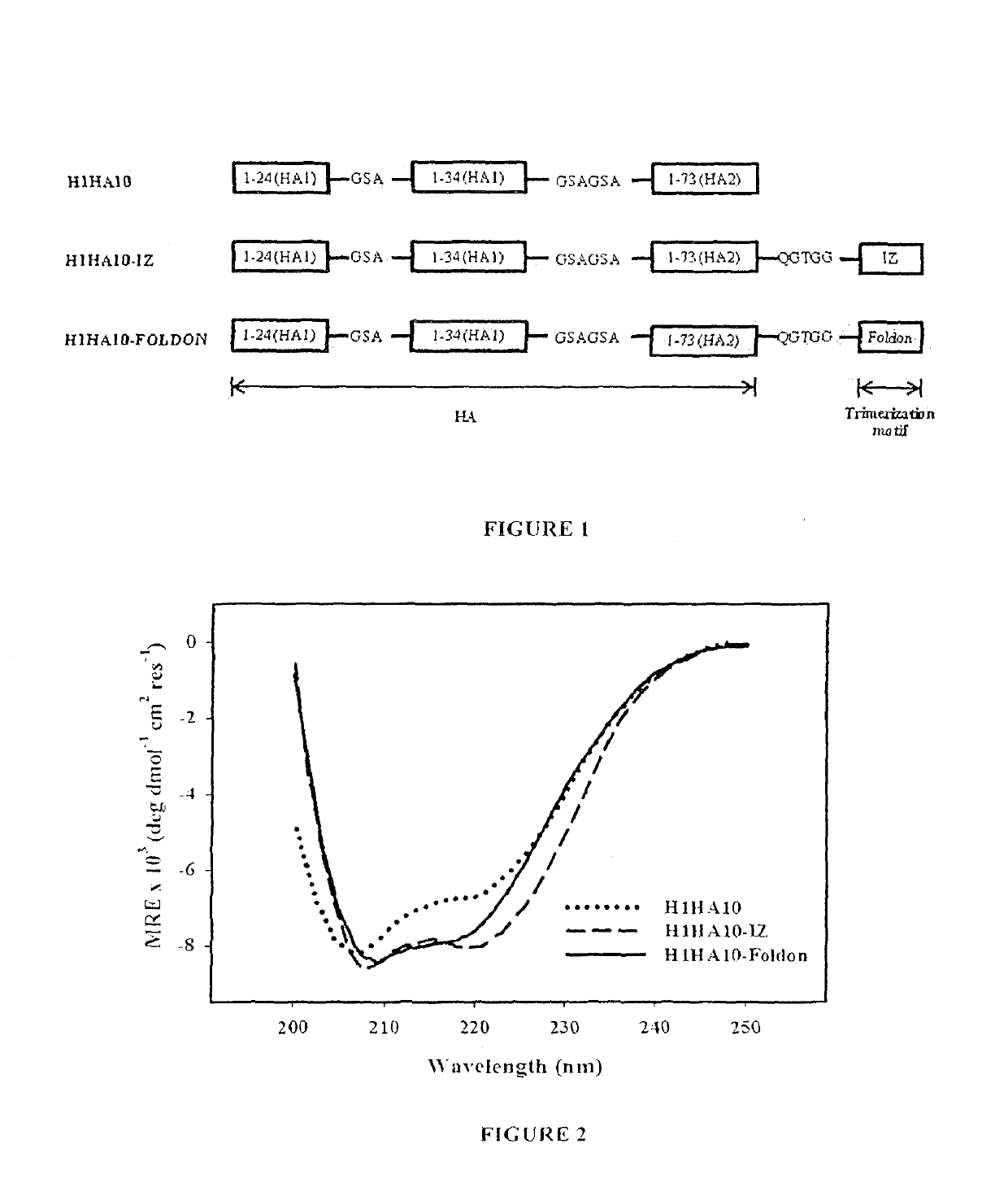Polypeptides for generating anti-influenza antibodies and uses thereof
a technology of polypeptides and antibodies, applied in the field of molecular biology, virology, immunology, can solve the problems of early attempts to express the ha2-subunit independently in a native, pre-fusion conformation failure, and further compromise of public health
- Summary
- Abstract
- Description
- Claims
- Application Information
AI Technical Summary
Problems solved by technology
Method used
Image
Examples
example 1
Materials and Methods
[0247]Sequence analysis: All non-identical, full-length flu sequences (H1N1:4241 sequences and H5N1:182 sequences, derived from human hosts) were obtained from the NCBI-Flu Database (www.ncbi.nlm.nih.gov / genomnes / FLU / FLU.html). H1N1 sequences were clustered at 99% homology using CD-HIT (Cluster Database at High Identity with Tolerance) to filter-out 465 unique, representative H1N1 sequences which were used for further analysis (Huang Y et al., Bioinformatics, 2010, 26(5), 680-682). These H1N1 sequences were multiply aligned using ClustalX (Higgins DG, et al., Gene, 1988, 73(l), 237-244). H1N1 (n=465) and H5N1 (n=182) sequences were also simultaneously aligned using ClustalX. The quality score for each column in the alignment file is a measure of residue conservation at that position. The quality scores were binned and mapped onto the crystal structure of H1N1 A / PR / 8 / 34 HA [Protein Data Bank (PDB) ID: 1RU7].
[0248]Cloning, expression, and protein purification: The...
example 2
Results (Immunogen / Polypeptide Design)
[0265]Antigenic differences between the HA surface glycoprotein of various influenza A viruses provides the basis for classification into 18 subtypes (H1-H18) (Tong S, et al., PLoS Pathog., 2013, 9(10), e1003657). Wide diversity and rapid antigenic variation of HA remains the principal challenge to the development of potent vaccines. Targeting conserved regions of HA offers a promising strategy to combat viral evolution and escape. We analyzed a large dataset (H1N1: 4241 and H5N1: 182 sequences) of Group-1 influenza virus sequences to identify conserved targets on HA. Consistent with previous results (Ellebedy AH et al., Front Immunol., 2012, 3, 5), the HA stem is more conserved as opposed to the highly-variable globular head domain. The residue conservation across all full-length, human isolates of H1 HA and Group-1 HA was mapped onto the crystal structure of H1N1 A / PR / 8 / 34 HA (PDB ID: 1RU7(Gamblin S J, et al., Science, 2004, 303(5665), 1838-18...
example 3
Results (Protein Purification and Biophysical Characterization of HA Stem Immunogens)
[0271]Protein solubility is a coarse indicator of proper folding and remains a crucial problem in heterologous expression systems. HA fragments expressed previously in E. coli formed inclusion body aggregates and required refolding (Bommakanti G, et al., J Virol., 2012, 86(24), 13434-13444; Song L, et al., PLoS One, 2008, 3(5), e2257). In contrast, all the designed immunogens / polypeptides as described herein, expressed in E. coli BL21(DE3) cells were purified from the soluble fraction of the cell culture lysate, suggesting proper folding and validation of the design protocol. The protein yields were about 10-15 mg / liter culture using unoptimized shake-flask cultures and were purified using a single, affinity-purification step.
[0272]CD-spectra indicated that all the proteins were folded and predominantly a-helical as expected. The trimerization motifs assist in the folding of H1HA10. H1HA10-IZ and H1...
PUM
| Property | Measurement | Unit |
|---|---|---|
| pH | aaaaa | aaaaa |
| concentration | aaaaa | aaaaa |
| path length | aaaaa | aaaaa |
Abstract
Description
Claims
Application Information
 Login to View More
Login to View More - R&D Engineer
- R&D Manager
- IP Professional
- Industry Leading Data Capabilities
- Powerful AI technology
- Patent DNA Extraction
Browse by: Latest US Patents, China's latest patents, Technical Efficacy Thesaurus, Application Domain, Technology Topic, Popular Technical Reports.
© 2024 PatSnap. All rights reserved.Legal|Privacy policy|Modern Slavery Act Transparency Statement|Sitemap|About US| Contact US: help@patsnap.com










